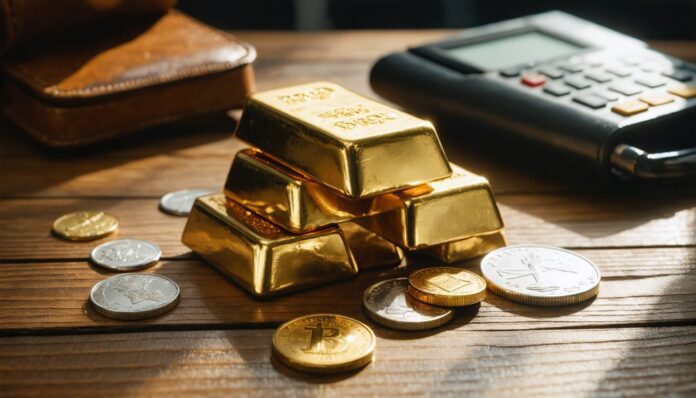If you want a hedge against inflation, currency weakness, or geopolitical shocks, precious metals give you tangible diversification and portfolio insurance but they don’t pay dividends or interest. You’ll face price volatility, storage and insurance costs, potential liquidity constraints, and counterparty or fraud risks with physical bullion. Institutional demand can support prices, yet macro swings and supply issues still move markets. Keep a small allocation and you’ll learn more about how to balance those trade‑offs.
Key Takeaways
- Pros: Tangible hedge against inflation and currency devaluation, preserving purchasing power over long periods.
- Pros: Diversifies portfolios and often acts as a safe haven during geopolitical or market stress.
- Cons: No income—returns depend entirely on price appreciation, not dividends or interest.
- Cons: Physical ownership incurs storage, insurance, security costs, and fraud/counterfeit risks.
- Risk: Prices can be highly volatile and illiquid in stressed markets, making quick large sales costly.
Why Investors Turn to Precious Metals
Confidence in preservation often drives investors to precious metals: you buy them because they’re a tangible hedge against inflation and currency devaluation, a diversification tool that doesn’t move in lockstep with stocks or bonds, and a safe haven when geopolitical tensions spike.
You turn to gold, silver, or platinum because they’ve preserved purchasing power over decades—14 ounces of gold bought a car in 1935 much like today—and because they act as an inflation hedge when prices rise or tariffs push costs up.
You also lean on metals to balance portfolios during stock and bond losses, reducing volatility with a modest allocation. Central banks and large financial institutions are among the largest holders of physical gold.
In times of geopolitical strain, increased central bank demand and record safe-haven flows confirm metals’ role as a geopolitical safe haven. Additionally, investors often allocate a small percentage of their portfolios to metals as portfolio insurance. Governments’ actions and economic uncertainty have pushed many institutions to accumulate more gold.
Risks and Challenges of Precious Metals Investing
Although precious metals can protect against some risks, they bring their own set of challenges you need to weigh carefully.
You’ll face market volatility driven by economic indicators, currency swings, and geopolitics, and you won’t earn dividends or interest — your gains rely on price appreciation that’s unpredictable.
Holding metals means ongoing storage costs, insurance, and security concerns; improper storage raises theft and fraud risks, including counterfeit or tungsten-plated items.
Different products carry different risk profiles: physical bullion is lower risk than futures or junior mining stocks, while collectibles add valuation and liquidity issues.
Operational issues like supply-chain, ESG concerns, and thin markets for some assets can limit exits. Large physical holdings can also be hard to sell quickly in stressed markets without price concessions liquidity risk.
Stay vigilant, join informed communities, and verify dealers to protect your position.
Gold, silver, platinum, and palladium are affected by macro drivers and industry demand, with diversification benefits for some portfolios. Additionally, investors should consider the sector’s historical performance and fund options when allocating capital to metals market coverage.
References
- https://global.morningstar.com/en-gb/funds/best-performing-funds-q3-2025
- https://www.straitsfinancial.com/insights/precious-metal-investment-trends-2025
- https://www.lbma.org.uk/articles/lbma-precious-metals-market-report-q2-2025
- https://sprott.com/insights/silver-investment-outlook-mid-year-2025/
- https://www.bullionvault.com/gold-news/infographics/ai-gold-precious-metal-price-forecasts
- https://certuity.com/insights/precious-metals-in-2025/
- https://silverinstitute.org/wp-content/uploads/2025/04/World_Silver_Survey-2025.pdf
- https://www.usgoldbureau.com/news/post/top-reasons-why-people-purchase-gold-precious-metals
- https://www.td.com/ca/en/personal-banking/products/personal-investing/precious-metals-gold-silver-platinum/precious-metals-considerations
- https://www.cbsnews.com/news/why-is-the-price-of-gold-rising-4000-ounce-economy/


